Bolex H16 User
For Practical Bolex H16 Filming
Viewfinders
Bolex Product Codes:- TRIFOC, TEVIS, VICON
There are three types of viewfinder made for the H16.
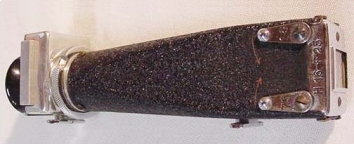 The
Trifocal viewfinder.
The
Trifocal viewfinder.
The first viewfinder Bolex made was the Trifocal Viewfinder which gives
the angles of view of three lenses.
It is defaultly set up to give the view of a 25mm lens and can be adjusted to give the field of view of a 15mm and a 75mm lens. This adjustment is made by moving the appropriate lever at the side of the Viewfinder in the direction of the arrow.
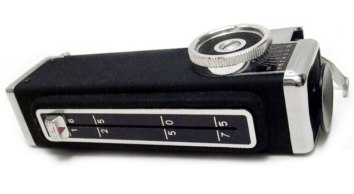 According
to a focal guide book on Bolex equipment from the period separate viewfinders
were available for telephoto lenses in focal lengths of 100, 150, and
200mm. If you wanted to upgrade a camera previously released with a Trifocal
viewfinder to a Octameter viewfinder (discussed below) Bolex would supply
you with a compete camera door which included the updated mounting brackets
on them.
According
to a focal guide book on Bolex equipment from the period separate viewfinders
were available for telephoto lenses in focal lengths of 100, 150, and
200mm. If you wanted to upgrade a camera previously released with a Trifocal
viewfinder to a Octameter viewfinder (discussed below) Bolex would supply
you with a compete camera door which included the updated mounting brackets
on them.
The Preview Viewfinder.
The second viewfinder gives focal lengths for lenses of 16, 25, 50 and
75mm by using a sliding lever that can be positioned at any one of the
focal lengths along the viewfinders side.
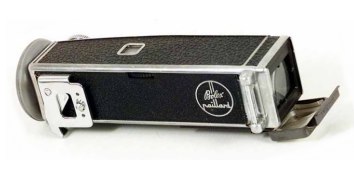 The
Octameter viewfinder.
The
Octameter viewfinder.
The third viewfinder Bolex produced is undoubtedly the best. This viewfinder
gives the angles of view of 16, 25, 50, 75, 100, plus 150mm lenses.
The angle of view is altered by turning the wheel on the side of the viewfinder until the required focal length appears in the window on the top of the viewfinder. The focal length for which the viewfinder is set can also be seen at the bottom of the image when looking through the viewfinder.
Accessories for the Octameter and Preview type Viewfinders
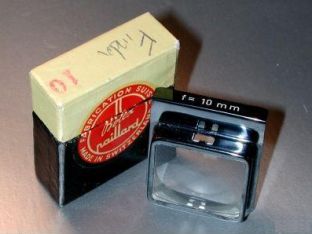 10mm
lens adapter Bolex Product Code:- CADIS
10mm
lens adapter Bolex Product Code:- CADIS
If you want to see what the image you are shooting looks like through
a 10mm lens then you would set the viewfinder to the lowest focal length
available on both viewfinders (which would be 16mm). Then add this 10mm
adapter by slipping it over the front of the viewfinder.
This adapter was supplied on later versions of the Octameter viewfinder in a sliding bracket (Bolex product code VITOC and VINON) which allows easy fitting and removal and makes it less easy to loose.
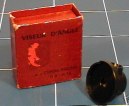 Right
angle finder Bolex Product Code:- VIANG
Right
angle finder Bolex Product Code:- VIANG
This fits on the back not the front of the viewfinder, in place of the
plastic eyepiece and it allows you to look at things people think you
are not looking at. It does not use the optics of the viewfinder at all.
The only use is to make people think you are looking at or filming what's
in front of the camera when in actual fact you are looking at what is
either 90° to your left or right depending on how you have positioned
it. A very naughty device indeed from Bolex.
 Extension
Bracket Bolex Product Code:- SUMET
Extension
Bracket Bolex Product Code:- SUMET
This bracket allows you to mount a viewfinder on the side of a Bayonet
mount camera such as an SB, SBM and EBM although not an EL which has missed
off the viewfinder mounting bracket altogether in place of clips to hold
an external battery. You can fit a viewfinder on a SB, SBM and EBM camera
already without this bracket because the camera door has the standard
mounting points and a viewfinder will fit on them unaided.
However bayonet cameras have a bigger lens mount with an extra bit of plastic which extends outward from the left side of the camera which will obscure the image through the viewfinder, hence the need for this bracket. If you only intend to use the viewfinder off the camera to get a general impression of what lens to use for a particular scene and then always clip it back on the camera and don't use it to frame what you are shooting then there is no need for this bracket.
This bracket first appeared as part of the standard kit of items that came with the Bolex stereo system. The reason being that the lens for that system overshot the left side of the camera also. Bolex just started to re manufacture it for this problem.
The problem of Parallax
 Because
the optical axis of any of the above viewfinders is not in line with the
optical axis of the taking lens, a correction has to be made in the position
of the viewfinder. The error that would otherwise result is known as parallax.
All the viewfinders discussed on this page are fitted with a parallax
correction device at the eyepiece. The eyepiece is moved sideways by means
of the screw immediately below it until the datum mark is set on the same
distance that the lens is focused upon.
Because
the optical axis of any of the above viewfinders is not in line with the
optical axis of the taking lens, a correction has to be made in the position
of the viewfinder. The error that would otherwise result is known as parallax.
All the viewfinders discussed on this page are fitted with a parallax
correction device at the eyepiece. The eyepiece is moved sideways by means
of the screw immediately below it until the datum mark is set on the same
distance that the lens is focused upon.
The top position for the Viewfinder is convenient when the camera has to be stored in its case, but a vertical parallax error is introduced which cannot be corrected on the finder. When the viewfinder is used on the side position, only a horizontal parallax error exists and this can be corrected. Another disadvantage of the top position is that the end of the Viewfinder covers and obscures the critical focusing screen if present.
The trifocal viewfinder can be used in two positions on the camera. It can be fixed to the two metal clips on the top of the camera or the two metal clips on the camera door. When placing the viewfinder in position, ensure that the guide markings found on the rear of the finder coincide (red dots for the top position, red dashes for the side position). Then introduce the feet of the viewfinder into the two metal clips in the appropriate position. Push the viewfinder well home and secure it by turning the milled ring so that it locks against the pin on the rear metal clip.
All the viewfinders discussed on this page were designed and first released in the 1950's for use on Bolex cameras that would be shooting regular 16mm film. However they should not make any noticeable difference to the image obtained if shooting Super 16 as far as I know.